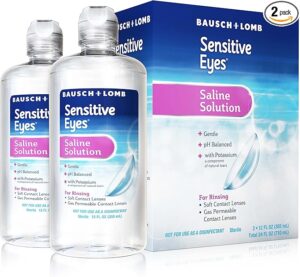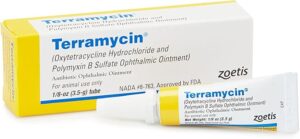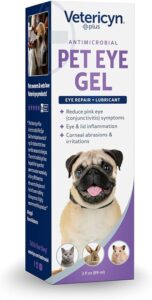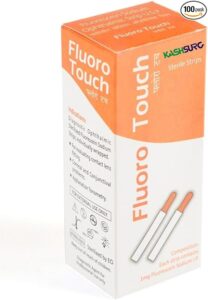At home treatment of conjunctivitis in a dog
How to help your dog recover
When there is a conjunctivitis in your dog, better known as pink-eye, his connective tissue (conjunctiva) that surrounds his eyeball is inflamed. In this case the pink parts of the inside of the eyelids and on the edge of the eyeball are not pink, but red and swollen. We often see purulent discharge here, but not always. In some cases, the white of the eye has also become a little red. This should not be confused with a red lump on the nose side of the eye. That we call a cherry eye and it is not an infection. In case of conjunctivitis dogs tend to squeeze their eyes a bit.
Symptoms of conjunctivitis or pink-eye in dogs
When there is a conjunctivitis, you can see the following symptoms:
- The inside of the eyelids and sometimes the eyeball itself are inflamed and have a dark red colour.
- There might be some transparant or purulent discharge in the eye corners visible.
- Crusts of dried discharge may occur
- The dog usually squeezes his eye/eyes a bit because his eye(s) hurts. Sometimes the dog also is sensitive to light.
- Most of the time the conjunctivitis doesn’t resolve by itself within a week.
Cause and treatment for conjunctivitis in dogs
Foreign object
It is important to think for yourself whether there might be an obvious cause for the conjunctivitis in your dog. For example, it often occurs as a result of rolling in the dirt or after swimming in not so clean water. Or perhaps you and your dog have been in the park and he/she got a little branch in his/her eye. In this case, it is important that you carefully examine the eye. If necessary, carefully lift the third eyelid (that is on the nose side of the eye) with blunt tweezers and see if there is anything behind it. However, this is only possible if your dog cooperates well. If your dog moves its head too much, it is better to leave the third eyelid alone. Otherwise you can cause more damage to the eye than there already is.
You can gently flush his eye with some clean tap water and a syringe or clean his eye-area with a wet cotton ball. Use bottled water if you are in an area where the water is not drinkable. You can also use an eye saline solution to rinse his eye.
If there was a foreign object visible in his eye and you were able to get it out than you don’t need to treat his eye more than you’ve done now. But if you are in doubt, just keep rinsing the eye with the conjunctivitis 3 times a day for about 2-3 days. That should be enough to clean the eye. Normally you see the redness of the conjunctiva disappear the next day.
A bacterial infection in the eye of your dog
In most cases there is a bacterial infection in the eye of your dog that is the cause for the conjunctivitis. In that case you see the redness of the mucous membranes of the eye, but also combined with yellow or green purulent discharge. In this case you should use an antibiotic-eye-ointment like the one below. Put this eye ointment twice a day for at least 5-7 days in his eye. Do not stop earlier, because the infection might look gone, but it really takes 5 days for it to be completely gone. If you stop too early the conjunctivitis most likely will return.
A viral infection in the eye of your dog
Sometimes there is a viral infection in the eye of your dog. There isn’t really a way to test this yourself. But most of the times there is a transparant discharge coming out of the eye of your dog. A viral infection will not react to an antibacterial ointment. So in this case your dog needs to fight the infection himself. But you can help him do that with a immune response stimulating eye ointment like the one below. Put this ointment 3 times a day in the eye. This way the ointment will boost his immune system in his eye and the ointment itself will flush out a lot of virus particles. If you want, and your dog doesn’t mind, you can also use this ointment more often than 3 times a day. In most cases 7 days of treatment is enough, but sometimes two weeks may be needed in order the suppress the virus.
Cat scratch on the eye as a cause for conjunctivitis in a dog
Do you have a cat at home? Or have you seen your dog have a run-in with a neighbor’s cat? Then it is possible that this cat has scratched your dog on his eye. If his cornea has a deep scratch it can easily have gotten infected by the cat-nail. And in that case the cornea is not able to heal. Most of the time you see a grey or white blurry looking smudge on your dog’s eye that you can not whipe away. Also his mucous membranes of the eye get swollen and red. If you think your dog might have a cat scratch, you’d best have this checked out by a veterinarian. If that is not possible you can also test this yourself with the following test.
You just need one strip per eye. Put a drop of water on the orange tip of the strip and bring the strip against the eyeball of your dog. The orange colour will spread over his eyeball. The orange color will attach to fibers in the scratch and turn green then. When the color is in the eye shine with a little bright ligt in his eye and look if you see a green spot in his eye. If you do so, try to use his eyelids to see if this spot moves. If that is not the case your dog has a scratch on his cornea. Note: the orange or green color can also drip out of his nose after a half a minute. This is a good sign and tells you that his tear duct is still functioning. But don’t worry if it doesn’t come out of his nose.
If there is a scratch in his eye, this will most likely heal by itself as long as there is no bacterial infection in his eye. So you need to give him the antibiotic eye ointment twice a day for at least a month. After that you can test his eye with the orange fluoresceine test (above). If the green dot still appears you need to keep on giving the antibiotic ointment. Just as long as the eye doesn’t pick up the color any more.





